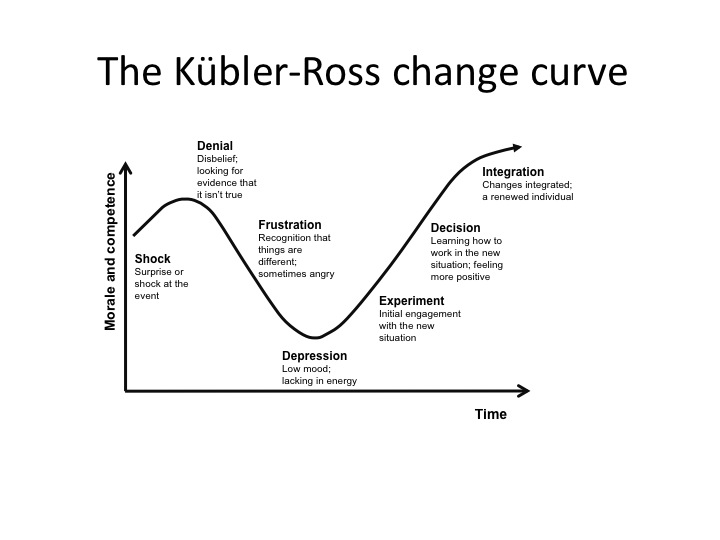If your organisation’s going through – or about to go through – a change, it pays to follow the curve – the Kubler-Ross change curve*.
Understanding the ups and downs of the ‘change curve’ will help you lead successfully through change and make sure you recognise what people in your organisation will go through. Major changes can spark all sorts of emotions and feelings in people, especially when they’re faced with the unknown. Knowing how to guide them through these feelings will help them travel along the curve and through the change process.
Elizabeth Kubler-Ross came up with the change curve model in 1969 to show what terminal patients go through following their diagnosis, before adapting it to fit any form of personal loss or trauma, including those related to what’s happening in their place of work.
There are five stages in the curve, which we’ll discuss in a bit more detail below and show you how they relate to any sort of change in an organisation.
1. Denial – This is where there’s a refusal to accept what’s happening. At this stage, people will be thinking ‘Change, what change?’ bury their heads in the sand, and likely to be suffering from anxiety or shock.
2. Anger – Denial and shock quickly turns to anger and frustration as people realise what’s happening isn’t going away, and they’re going to have to deal with it.
3. Insecurity – The ‘How will this affect me?’ stage where worry and fear kicks in.
4. Acceptance – You might think this is the last stage, but in fact it’s not quite as once people have accepted what’s happening, they still to take stock so they can move on. At this point, they might not be happy about what’s happening, and will often accept it grudgingly.
5. Moving on – Not only have they accepted things, they understand how to go forward and can see what’s in store in the future.
Managing the curve
There are ways to help manage the curve and smooth out the peaks and troughs you can see.
During stage one, it’s important to communicate fully to minimise shock and explain exactly what’s happening. People will try and ignore it so ask for their opinion on the change and try and speed up the journey along the curve.
As the next two stages get going, the trick is to be patient and keep the lines of communication from stage one open. You’ll need to listen, show empathy and let everyone’s point of view be heard. One of the most difficult things to deal at this point with is not taking others’ comment personally. Remember emotions are involved, especially as people become concerned for their future.
Once you get to phase four, it can get a bit easier. What’s crucial here is to let other people take some responsibility on, and offer encouragement to everyone involved. Creating goals is a good idea as people become more positive. Spirits are up here as the curve starts to head the right way, so make sure they stay that way.
Finally everyone’s moving forward and the curve really goes on an upward trajectory at stage five. It’s time to reflect and talk about what happened (and what’s happening). Offer and ask for feedback, and don’t be afraid to celebrate success – you deserve it as you’ve survived the curve.
How you behave will drive this success. It’s about being positive, respectful and acting with integrity. Simple things like listening, thinking before you take action and showing empathy will work wonders.
Make sure your organisation follows the curve when you undergo change. The quicker everyone gets there, the easier your change will be.
———————————————————————
*Resource: https://en.wikipedia.org/wiki/K%C3%BCbler-Ross_model








